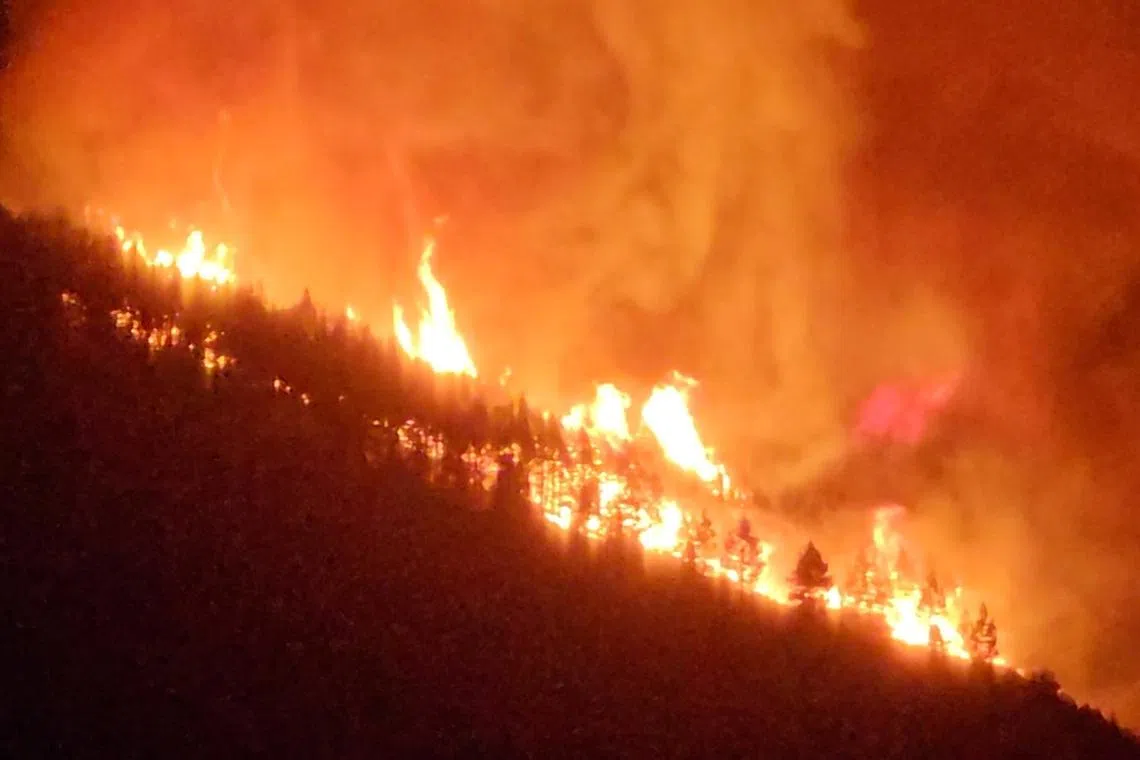Wildfires can have global impact and are set to intensify, experts say
Sign up now: Get ST's newsletters delivered to your inbox

Flames and smoke rise as wildfire burns on the Canary island of Tenerife, Spain.
PHOTO: REUTERS
Follow topic:
SINGAPORE – Devastating wildfires of the sort that have scorched Hawaii and swathes of Canada and Greece are likely to become frequent in the future as global warming creates the right conditions for intense blazes, scientists say.
The increasing number of extreme wildfires could, in turn, exacerbate climate change and lead to yet more fires, damage the ozone layer and severely impact the globe, two leading fire scientists say.
Writing in the journal Science, they explain that global warming is causing more intense heating of the planet that can quickly dry out the landscape, priming it for fires to start and spread.
Already, fire seasons have become longer in many places, including Australia, North America and Europe, and some fires have become so intense that no amount of equipment and number of firefighters can put them out.
Scientists are increasingly learning that major fires can have global impacts.
“Fire is complex. But it’s complex on a global scale.
“I think this was the main thing we’re trying to get across,” said Professor Jason Sharples, who specialises in bushfire dynamics at University of New South Wales Canberra.
He co-authored the article published on Aug 10 with Professor David Bowman, an expert in pyrogeography and fire science at the University of Tasmania.
“Every bad fire season, we get a whole bunch of new lessons,” Prof Sharples told The Straits Times on Tuesday.
Referring to the deadly wildfire in Maui, Hawaii,
“We are starting to see these things happening in the tropics. Hawaii is a tropical location. They’re not used to that sort of intense fire activity.”
Both scientists reviewed scientific evidence from the Australian Black Summer fires of 2019-20 that killed 33 people and burned more than 24 million hectares of land.
Three billion wild animals were killed, injured or displaced.
The fires released the equivalent of 80 per cent of Australia’s combined annual fire and fossil fuel emissions.
Prof Sharples said the huge spike in emissions from these and other major fires creates positive feedback that will lead to more fires – as adding more carbon dioxide (CO2) into the air increases the effects of global warming.
Intense wildfires can trigger huge fire thunderstorms, called pyrocumulonimbus clouds, which can create their own weather and fuel yet more fires.
These storms can pump vast amounts of smoke particles and CO2 high into the stratosphere, a layer of the atmosphere that starts at between 6km and 20km above the earth’s surface and extends to about 50km.
Smoke from the Australian blazes thinned the protective ozone layer by up to 5 per cent, research released in 2022 showed.
Ozone in the stratosphere helps shield the planet from dangerous cancer-causing ultraviolet radiation from the sun.
A total of 44 fire thunderstorms were recorded during the Black Summer fires and dozens have been recorded during Canada’s ongoing fire crisis, which has burned 13.6 million hectares so far.
Smoke from the Black Summer fires circled the globe and also triggered vast algal blooms in the Southern Ocean, the effects of which are still being studied.
Prof Sharples said the smoke also affected stratospheric circulation patterns that caused a temporary cooling of the earth’s surface. This possibly contributed to a three-year La Nina that triggered widespread flooding across eastern Australia from 2020 to 2022, though more study is also needed.
Both scientists said there is an urgent need to better prepare for extreme fires.
“The fires we expect to face in future are going to be bigger and more dangerous than those we’ve experienced in the past, so we can’t just keep doing the same things to combat them,” Prof Bowman said in a media statement.
He said there needs to be a rethink of prescribed burning ahead of fire seasons, intended to reduce the fuel load for fires and therefore reduce the intensity of blazes.
Prof Sharples told ST that ideas include using animals such as goats to graze down the understory of forests and shrubland near urban settlements or machines to trim branches and other flammable materials.
Another idea is to incorporate cultural burning practices of the Aborigines that go back thousands of years. Such practices are usually on a smaller scale and applied regularly to small areas to create a patchwork of habitats.
“To address these large fires, we need to think about how to extend those practices again, to apply these sorts of ideas at scale,” Prof Sharples said.
Also important is better analysis of areas most likely to burn intensely and to target these spots for prescribed burning.
But more thought and planning are needed to better understand the health impacts of more targeted burning on people and the environment, he said.
More immediately, Australia is preparing for another fire season.
The current El Nino event is forecast to create hotter and drier conditions that some experts have already warned could trigger intense grass fires after three years of above-average rain.
The future is challenging for Australia, Prof Sharples said.
“It’s pretty much certain that we’re going to end up with more seasons like Black Summer in our future.”



